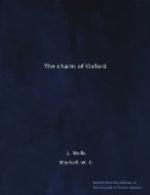This college then unites the traditions of two old halls, and of its own predecessor, and from all of them it derives some famous names. Hart Hall was the home of John Selden, one of the greatest of English scholars; Hertford College had an undistinguished English prime minister in Henry Pelham, and a most distinguished leader of opposition in Charles James Foxe; while Magdalen Hall was even more rich in traditions, as being the home of the translator of the Bible, William Tyndale, as the centre of Puritan strength in the Laudian days, when from its ranks were filled the vacancies all over Oxford caused by the expulsions of Royalists, and finally as having trained Lord Clarendon, famous as Charles II’s minister, still more famous as the historian, whose monumental work was one of the first endowments of the Oxford Press.
All these traditions are now concentrated in the one college, and, as has been said, the buildings have been greatly extended to meet the needs of the new foundation. When Hertford College is completed according to the plans already drawn by Sir Thomas Jackson, it will reach from All Souls’ to Holywell. This last northern part of its front has been delayed by the European War.
The new—or, rather, the revived—college has, as yet, hardly had time to make Oxford history, but the influence of its second Principal. Dr. Boyd, whose long reign, happily not yet over, began in 1877, has had the result of finding for Oxford new benefactors in one of the wealthiest of the London City Companies; the Drapers’ magnificent gifts of the new Science Library and of the Electrical Laboratory are good instances to show that the days of the “pious founder” are not yet over.
[Plate XXIV. Hertford College : The Bridge]
ST. EDMUND HALL
“Or wander down an ancient street
Where mingling ages quaintly meet,
Tower and battlement, dome and gable
Mellowed by time to a picture sweet.”
A. G. BUTLER.
The group of buildings, shown in Plate XXV, is not only picturesque— it also illustrates Oxford history from more than one point of view.
The apse of the Chapel of Queen’s on the left belongs to a building already spoken of, which is the most perfect example of a small basilican church in Oxford. The church tower in the centre, though itself dating from the fourteenth century, is the most modern part of one of the oldest churches in Oxford, St. Peter in the East. The crypt and the chancel of this church go back to the time of the Conquest, and are probably the work of Robert d’Oili, to whom William the Conqueror gave the city of Oxford; he was first an oppressor and then a benefactor; in the former character, he built the castle keep, still standing near the station; in the latter, he was the builder, besides St. Peter, of the churches of St. Michael and of the Holy Cross; parts of his work survive in all three.




